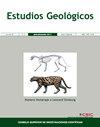Correlación entre parámetros químicos, cristalográficos y espectroscópicos en la termometría de grafito aplicada a una aureola de contacto del monzogranito de La Soledad (Andes venezolanos)
IF 0.8
4区 地球科学
Q3 GEOLOGY
引用次数: 0
Abstract
Graphite samples from a metamorphic contact aureole between phyllites of the Cerro Azul Association (Palaeozoic) and La Soledad Monzogranite, in the Venezuelan Andes, were studied by chemical (% inorganic carbon and isotopic distribution), crystallographic (DRX) and spectroscopic (Raman) techniques in order to assess changes in the graphite in the vicinity of the contact, the correlation between the different parameters, and the determination of the higher temperature reached by the host rock during igneous intrusion. The δ13C reached less negative values near the monzogranite, caused by devolatilization; the graphite present just in contact with the pluton experienced retrograde recrystallization, which causes a shift towards more negative values. The calculated degree of graphitization intervals (GD = 53–80) corresponds to a well-structured mineral with ordered packaging. The peak metamorphic temperature at the contact was calculated from crystallographic (XRD) and spectroscopic (Raman) parameters with great agreement in both techniques, registering the 528 ± 16 and 526 ± 20 oC respectively. The metapelitic rocks reached the Cordierite Zone (cordierite + biotite + muscovite) in the contact aureole where the graphite is well ordered and in hexagonal microtexture. Factors such as fluid activity and the subsequent retrograde recrystallization have an effect on isotopic redistributions after the intrusive event, as well as on the crystallinity change rate with the temperature, avoiding a clear correlation between the isotopic variations of 13C in graphite and the temperature.应用于la Soledad二长花岗岩(委内瑞拉安第斯山脉)接触光环的石墨温度测定法的化学、晶体学和光谱参数的相关性
采用化学(%无机碳和同位素分布)、晶体学(DRX)和光谱(拉曼)技术对委内瑞拉安第斯山脉Cerro Azul Association(古生代)和La Soledad二长花岗岩千层岩之间的变质接触光圈中的石墨样品进行了研究,以评估接触附近石墨的变化、不同参数之间的相关性。并测定了火成岩侵入时寄主岩所达到的较高温度。δ13C在二长花岗岩附近的负值较小,这是由脱挥发引起的;与冥王星接触的石墨经历了逆行再结晶,这导致了向负值的转变。计算得到的石墨化度区间(GD = 53 ~ 80)对应于结构良好、包装有序的矿物。根据晶体学(XRD)和光谱(Raman)参数计算出的接触处的峰值变质温度与两种技术非常一致,分别为528±16℃和526±20℃。变质长石在接触光晕中到达堇青石带(堇青石+黑云母+白云母),石墨排列有序,呈六角形显微结构。流体活动性和随后的逆行再结晶等因素影响了侵入事件后的同位素重分布,以及结晶率随温度的变化,使得石墨中13C的同位素变化与温度之间没有明显的相关性。
本文章由计算机程序翻译,如有差异,请以英文原文为准。
求助全文
约1分钟内获得全文
求助全文
来源期刊

Estudios Geologicos-Madrid
GEOLOGY-
CiteScore
1.40
自引率
14.30%
发文量
6
审稿时长
>12 weeks
期刊介绍:
Since 1945 Estudios Geologicos publishes original research works, as well as reviews, about any topic on Earth Sciences.
Estudios Geologicos is published as one yearly volume, divided into two half-yearly issues. It is edited by the Spanish National Research Council (Consejo Superior de Investigaciones Científicas, CSIC) at the Instituto de Geociencias (CSIC-UCM).
Estudios Geologicos provides free access to full-text articles through this electronic edition. Accepted articles appear online as "Forthcoming articles" as soon as the galley proofs have been approved by the authors and the Editor-in-Chief. No changes can be made after online publication.
 求助内容:
求助内容: 应助结果提醒方式:
应助结果提醒方式:


